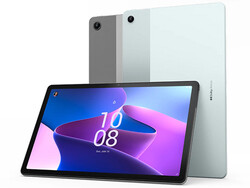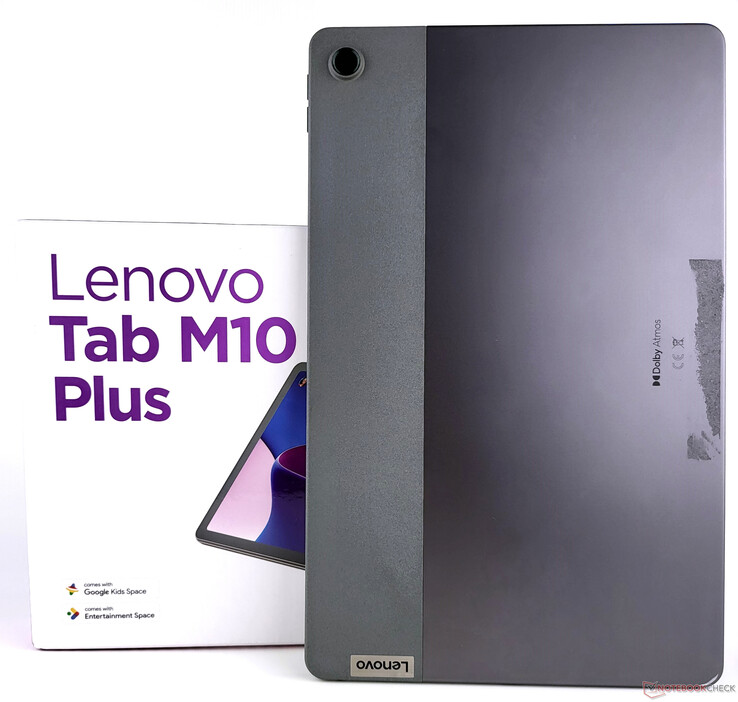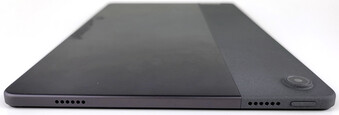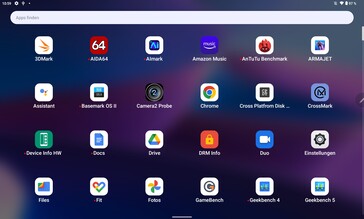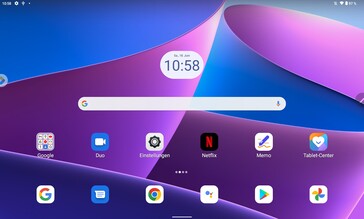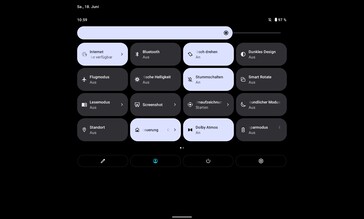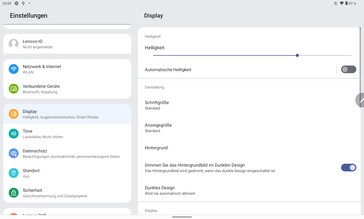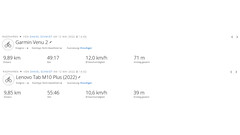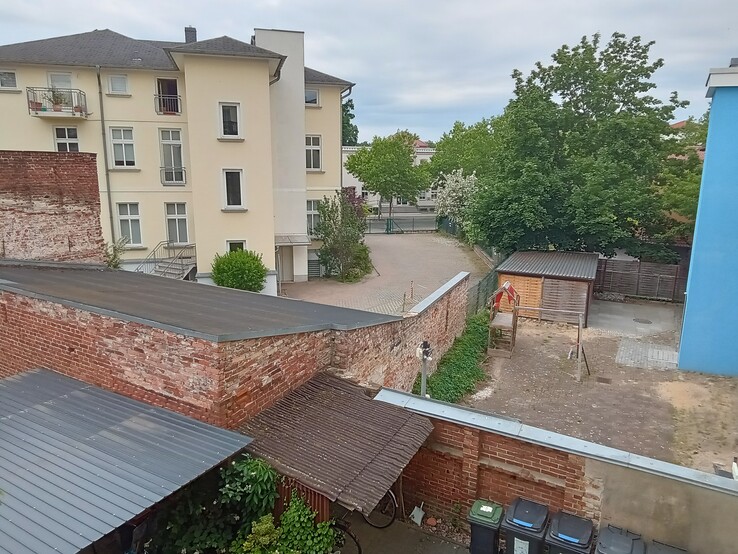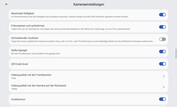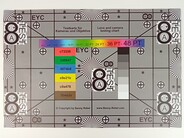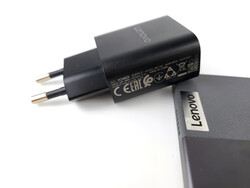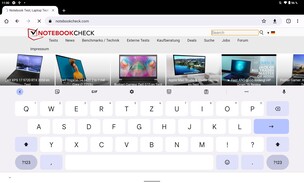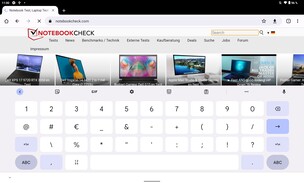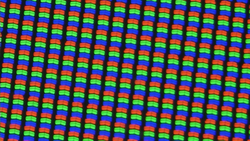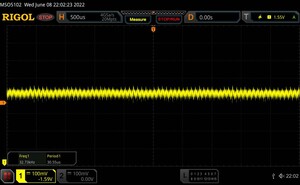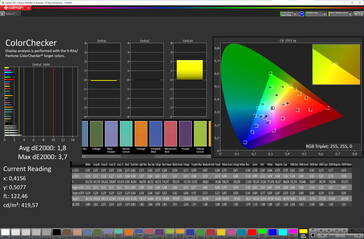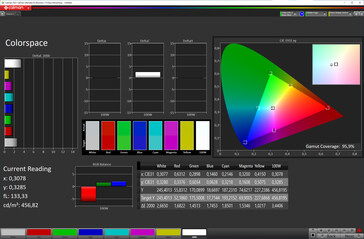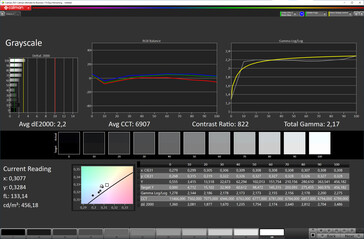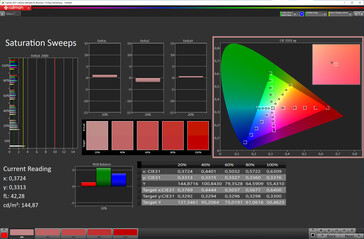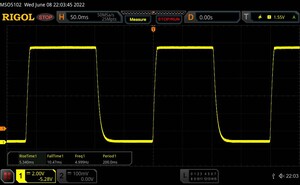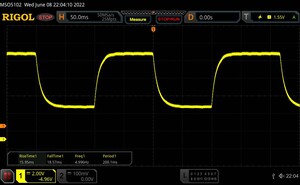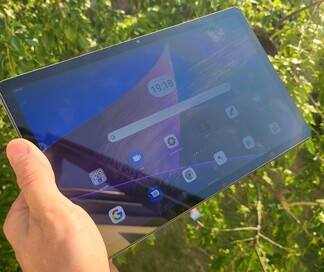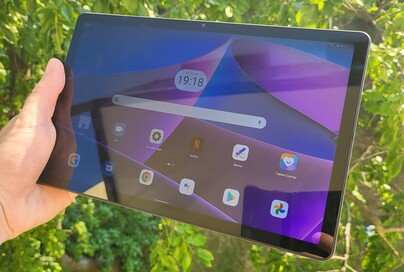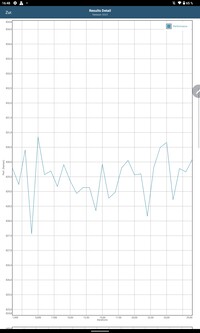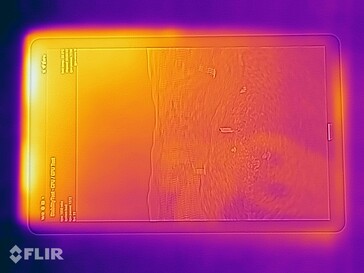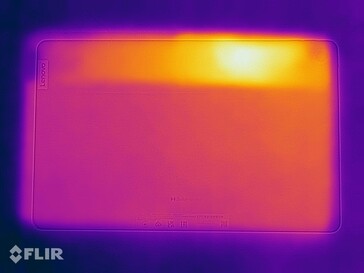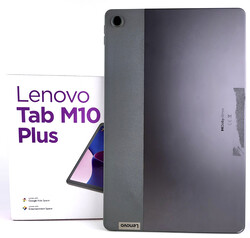Lenovo Tab M10 Plus 2022 (Gen 3) review: Affordable tablet with 2K display and stylus support
With the Tab M10 Plus Gen 3, Lenovo has expanded its Android lineup with another inexpensive multimedia tablet - prices start at an MSRP of 249 Euros (~$260). The third-generation M10 Plus has four speakers and a relatively high-resolution 2K IPS panel, but it only offers a refresh rate of 60 Hz. In return, the display can be used with the proprietary Lenovo Stylus, something that is hard to find in this price range.
A MediaTek Helio G80 is the standard in the Tab M10 Plus Gen 3. Depending on the model variant, Lenovo equips it with 3 to 6 GB of RAM and 32 to 128 GB of flash storage, which can be expanded by up to 1 TB via a microSD memory card. There's also an LTE variant, but it's not based on the Helio SoC, but on a Qualcomm Snapdragon 680. This leads to further differences apart from the 4G access, which we'll cover in this review.
Possible contenders in comparison
Rating | Date | Model | Weight | Height | Size | Resolution | Best Price |
|---|---|---|---|---|---|---|---|
| 82.5 % | 07/2022 | Lenovo Tab M10 Plus Gen 3 Helio G80, Mali-G52 MP2 | 465 g | 7.45 mm | 10.61" | 2000x1200 | |
| 84.1 % | 11/2021 | Lenovo Tab P11 Plus Helio G90T, Mali-G76 MP4 | 490 g | 7.5 mm | 11.00" | 2000x1200 | |
| 80.9 % | 04/2022 | Huawei MatePad T10S Kirin 710A, Mali-G51 MP4 | 450 g | 7.85 mm | 10.10" | 1920x1200 | |
| 81 % | 02/2022 | Samsung Galaxy Tab A8 2022 T618, Mali-G52 MP2 | 508 g | 6.9 mm | 10.50" | 1920x1200 | |
| 80.5 % | 03/2022 | Teclast T40 Pro T618, Mali-G52 MP2 | 480 g | 9.2 mm | 10.36" | 2000x1200 |
Case - Lenovo Tab M10 Plus in two colors
The affordable mid-range tablet from Lenovo has a pleasing feel, and the screen-to-body ratio is a solid 80.3%. Compared with the second generation, numerous improvements have been made to the Tab M10 Plus Gen 3, starting with the design. The screen's bezels are symmetrical on all four sides of the 2022 model, and the display's edges are curved. Furthermore, with a thickness of only 7.5 mm, the Lenovo tablet is very slim and, at only 465 g, it's pleasantly light for a 10.6-inch device.
The metal case is available in a two-tone design in Storm Gray and Frost Blue. As with the Tab P11 Plus, Lenovo uses a kind of matte surface for the top part of the back, which offers a good grip in addition to being a design element that doesn't have a significant impact on the case's rigidity. The lower part is made of matte brushed aluminum. The areas on the metal case that are covered with stickers are really hard to clean, and they leave some ugly residues - the manufacturer should urgently make adjustments here.
In contrast to the Tab P11 series, Lenovo doesn't provide its Tab M10 Plus Gen 3 with an official IP certification. Consequently, the tablet shouldn't be used in the rain.
Connectivity - Lenovo tablet with 3.5 mm audio jack
The Tab M10 Plus Gen 3 ships either with eMCP or uMCP storage. This is due to the MediaTek Helio G80's lack of compatibility with the UFS standard. The internal eMMC 5.1 storage has a capacity of 64 GB in our Wi-Fi version of the Lenovo tablet. After deducting the operating system, approximately 49 GB is still available. Users who need more capacity can expand the storage by up to 1 TB via microSD cards that support exFAT. Files larger than 4 GB can be saved on the storage medium thanks to the exFAT file format. Users who choose the LTE version can also insert a nano SIM in the card slot.
Both variants of the Tab M10 Plus Gen 3 feature an FM radio, a 3.5 mm audio jack, and a quad speaker system. The Lenovo tablet also supports Wi-Fi Display and USB OTG. Data can then be accessed via the USB Type-C interface, such as for playing back video material. This requires a corresponding adapter, which isn't included with the Lenovo Tab. Additional external peripherals, such as external keyboards, can also be connected via the USB 2.0 port.
microSD card reader
The built-in microSD slot supports the latest SDHC and SDXC standards. In combination with our Angelbird AV PRO V60 reference card, the performance in the Cross Platform Disk test is compelling. However, the Tab M10 Plus Gen 3 is quite slow when it comes to copying speeds at only 16 MB/s.
| SD Card Reader - average JPG Copy Test (av. of 3 runs) | |
| Samsung Galaxy Tab A8 2022 (Angelbird AV Pro V60) | |
| Lenovo Tab P11 Plus (Angelbird V60) | |
| Teclast T40 Pro (Angelbird AV Pro V60) | |
| Huawei MatePad T10S (Angelbird V60) | |
| Lenovo Tab M10 Plus Gen 3 (Angelbird AV Pro V60) | |
Cross Platform Disk Test (CPDT)
Software - Lenovo Tab M10 Plus with Android 12
The Lenovo tablet is based on Android 12, and Lenovo combines it with its own user interface. At the time of testing, the security updates are at the level of May 2022 and therefore quite up to date. According to the manufacturer's update matrix, the Tab M10 Plus Gen 3 will be provided with software support for security patches until April 2025. However, Lenovo doesn't specify the number of major Android updates that will follow. Android 13 is expected to be rolled out to the M-series tablet next year.
The software, which is based on stock Android, includes little bloatware and account management for multiple users. In addition, the Tab M10 Plus Gen 3 offers access to Google's Entertainment Space as well as Google Kids Space. With the parental controls of the Family Link app, it's possible to manage the available content and set screen time limits. Thanks to the DRM-L1 certification, you can stream content in high resolution on the 10.6-inch display.
Communication and GNSS - Lenovo Tablet with Wi-Fi 5
Our review sample is the Wi-Fi version of the Tab M10 Plus Gen 3, which is equipped with Wi-Fi 5 and Bluetooth 5.0. The 4G version with Qualcomm's Snapdragon X11 modem also supports LTE CAT13 and Bluetooth 5.1. Contactless payments via NFC aren't possible with either tablet model. In combination with the Asus ROG Rapture GT-AXE11000, the Lenovo Tab achieves a peak transfer rate of about 350 Mb/s, which is satisfactory but not particularly fast.
| Networking | |
| iperf3 transmit AX12 | |
| Lenovo Tab P11 Plus | |
| iperf3 receive AX12 | |
| Lenovo Tab P11 Plus | |
| iperf3 receive AXE11000 | |
| Lenovo Tab M10 Plus Gen 3 | |
| Samsung Galaxy Tab A8 2022 | |
| Teclast T40 Pro | |
| Huawei MatePad T10S | |
| iperf3 transmit AXE11000 | |
| Samsung Galaxy Tab A8 2022 | |
| Teclast T40 Pro | |
| Lenovo Tab M10 Plus Gen 3 | |
| Huawei MatePad T10S | |
The Wi-Fi version of the Tab M10 Plus Gen 3 is also suitable for navigation purposes since it can determine the current position via the GPS (L1), Galileo (E1), BeiDou, and GLONASS satellite systems. In order to make a comparison, we tracked a route with a Garmin Venu 2 in parallel.
The positioning accuracy is very solid in practice. However, there are some deviations from the route selected and the Garmin smartwatch in our course profile. Users looking for a huge navigation device for car trips could achieve better results with the 4G version that includes A-GPS.
Cameras - Lenovo Tab M10 Plus with single camera
An 8 MP lens with a fixed focus is available at the front for users of the Tab M10 Plus Gen 3. However, beyond video calls, you shouldn't expect much from the front-facing camera located above the display, since selfies are quite soft, and the exposure doesn't work properly often - especially in portraits. Due to the relatively low resolution, the detail reproduction in pictures isn't one of the strengths of the inexpensive mid-range tablet.
The rear-facing 8 MP camera with no LED flash promises better image sharpness due to its autofocus, but it's more suitable for taking pictures of documents and memos in everyday use. The base sharpness at the center of the photos is still decent, but details get lost in blurriness towards the edges. We weren't always impressed by the colors, either. The photos of the 8 MP camera show a visible red cast at times.
Although the resolution of both cameras is identical, the rear-facing lens can record videos at 1080p and 30 fps, while the selfie camera only has an HD option.
We subject the rear-facing main camera to further tests under controlled light conditions. With the ColorChecker Passport, we analyze the color reproduction of the 8 MP lens in comparison to the actual reference colors. We take measurements once in full studio lighting and once at a light intensity of 1 lux. Colors are quite well reproduced with the Tab M10 Plus, and the deviations don't result in any real shortcomings for a tablet. The typical brightening is seen in comparison to the reference colors.
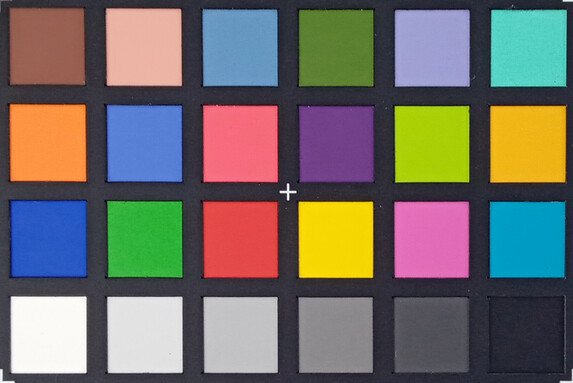

Accessories and warranty - Lenovo tablet with charger
The mid-range tablet comes with a 10-watt modular power adapter and a USB cable. Lenovo also offers an optional 20-watt power adapter for the Tab M10 Plus Gen 3. The compatible Lenovo Precision Pen 2 with its 4,096 pressure levels is sold separately for around 50 Euros (~$52). A keyboard pack with a keyboard and trackpad isn't available for the affordable Tab M model.
In Germany, Lenovo grants a 24-month warranty for its tablet. You can also extend the warranty to a maximum of three years as well as purchase the Lenovo Accidental Damage Protection (about 155 Euros (~$162)). The latter covers operational and structural damage caused by accidents like drops or spilled liquids.
Input devices and handling - Lenovo Tab M10 Plus with stylus support
The Tab M10 Plus Gen 3 features a 10-point multitouch-capable screen. Inputs with the finger are quickly implemented on the 10.6-inch IPS panel. Due to the 60 Hz, animations don't look as smooth as on displays with 90 Hz or more. But not only does the presentation of content "suffer" from the low refresh rate, but also the typing and drawing experience. Lenovo advertises the Tab M10 Plus Gen 3 as being compatible with the Precision Pen 2 stylus, but the spec sheet also mentions the Lenovo Active Pen 3. Since neither of them is included with our review sample, we are unable to check the stylus input performance of the budget Lenovo Tab.
Unfortunately, the Tab M10 Plus Gen 3 doesn't have a fingerprint sensor. Nevertheless, unlocking via biometric facial identification works reliably and usually fast enough in good light. However, the 2D method, which only works with the front-facing camera, makes facial recognition quite insecure.
Display - Lenovo Tab with IPS panel
The mid-range tablet measures 10.6 inches diagonally with a 16:10 format. The roughly 27 cm IPS display has a resolution of slightly over Full HD at 2,000x1,200 pixels, which results in a pixel density of 220 ppi; this isn't very high, but it's sufficient. The Lenovo tablet reaches its maximum brightness at 516 cd/m² on a white background. The more realistic APL18 measurement shows a similar 490 cd/m².
The Tab M10 Plus Gen 3 doesn't make use of traditional PWM for brightness control, but it does exhibit a high-frequency flickering.
| |||||||||||||||||||||||||
Brightness Distribution: 85 %
Center on Battery: 510 cd/m²
Contrast: 1041:1 (Black: 0.49 cd/m²)
ΔE Color 1.8 | 0.5-29.43 Ø5
ΔE Greyscale 2.2 | 0.57-98 Ø5.3
95.9% sRGB (Calman 2D)
Gamma: 2.17
| Lenovo Tab M10 Plus Gen 3 IPS LCD, 2000x1200, 10.61 | Lenovo Tab P11 Plus IPS, 2000x1200, 11.00 | Huawei MatePad T10S LCD IPS, 1920x1200, 10.10 | Samsung Galaxy Tab A8 2022 TFT-LCD, 1920x1200, 10.50 | Teclast T40 Pro IPS, 2000x1200, 10.36 | |
|---|---|---|---|---|---|
| Screen | -48% | -48% | -107% | -38% | |
| Brightness middle | 510 | 410 -20% | 285 -44% | 368 -28% | 433 -15% |
| Brightness | 480 | 400 -17% | 282 -41% | 346 -28% | 412 -14% |
| Brightness Distribution | 85 | 83 -2% | 91 7% | 91 7% | 86 1% |
| Black Level * | 0.49 | 0.29 41% | 0.3 39% | 0.61 -24% | 0.48 2% |
| Contrast | 1041 | 1414 36% | 950 -9% | 603 -42% | 902 -13% |
| Colorchecker dE 2000 * | 1.8 | 4.47 -148% | 3.53 -96% | 6.9 -283% | 3 -67% |
| Colorchecker dE 2000 max. * | 3.7 | 8.84 -139% | 5.84 -58% | 11.4 -208% | 7.2 -95% |
| Greyscale dE 2000 * | 2.2 | 5.1 -132% | 6.2 -182% | 7.7 -250% | 4.4 -100% |
| Gamma | 2.17 101% | 2.248 98% | 2.044 108% | 2.16 102% | 2.12 104% |
| CCT | 6907 94% | 7966 82% | 8130 80% | 8547 76% | 7003 93% |
* ... smaller is better
Screen Flickering / PWM (Pulse-Width Modulation)
| Screen flickering / PWM detected | 32730 Hz | ||
The display backlight flickers at 32730 Hz (worst case, e.g., utilizing PWM) . The frequency of 32730 Hz is quite high, so most users sensitive to PWM should not notice any flickering. In comparison: 53 % of all tested devices do not use PWM to dim the display. If PWM was detected, an average of 17900 (minimum: 5 - maximum: 3846000) Hz was measured. | |||
Series of measurements with fixed zoom level and different brightness settings
The mid-range tablet's black level of 0.49 cd/m² is only decent for an IPS panel, but the good brightness still ensures a higher-contrast display of over 1:1,000. Moreover, our analysis using the spectrophotometer and CalMAN software reveals relatively low average deltaE deviations compared to the sRGB color space. Besides two color profiles, the color temperature can also be adjusted in the settings menus. Regarding the colors, there's a noticeable deviation from the target in the case of red, but this won't be significant in everyday use.
Display Response Times
| ↔ Response Time Black to White | ||
|---|---|---|
| 15.81 ms ... rise ↗ and fall ↘ combined | ↗ 5.34 ms rise | |
| ↘ 10.47 ms fall | ||
| The screen shows good response rates in our tests, but may be too slow for competitive gamers. In comparison, all tested devices range from 0.1 (minimum) to 240 (maximum) ms. » 32 % of all devices are better. This means that the measured response time is better than the average of all tested devices (21.5 ms). | ||
| ↔ Response Time 50% Grey to 80% Grey | ||
| 34.52 ms ... rise ↗ and fall ↘ combined | ↗ 15.95 ms rise | |
| ↘ 18.57 ms fall | ||
| The screen shows slow response rates in our tests and will be unsatisfactory for gamers. In comparison, all tested devices range from 0.2 (minimum) to 636 (maximum) ms. » 42 % of all devices are better. This means that the measured response time is similar to the average of all tested devices (33.7 ms). | ||
The solid contrast ratio combined with the good luminance of the IPS panel provides sufficient legibility outdoors - but it shouldn't be too sunny. Content isn't really legible in direct sunlight - the panel reaches its limits here even without reflections.
Thanks to the liquid crystal display with in-plane switching technology (IPS), content is presented relatively color accurately even at flat viewing angles. However, a loss in brightness is perceptible when viewing the device from the sides.
Performance - Lenovo tablet with MediaTek SoC
The non-LTE Tab M10 Plus Gen 3 is equipped with a MediaTek Helio G80 that is manufactured in a 12 nm FinFET process. The chipset has 8 CPU cores in two clusters (Cortex-A75, Cortex-A55), and it integrates an ARM Mali-G52 MP2 running at up to 950 MHz.
The mid-range tablet makes a decent impression in everyday use, but we did experience some stutters during the test period. In addition, the Tab M10 Plus Gen 3 is quick to release opened apps from its RAM, although it's actually sufficient at 4 GB. However, the M10 model doesn't exhibit the rough performance deficits of the Tab P11 Plus; Lenovo seems to have done a better job in general with the Android 12 port compared to last year.
The low-priced mid-range tablet performs solidly in our CPU benchmark package, but the Tab M10 Plus Gen 3 can't come close to the results of the Helio G90T in its sibling, the Tab P11 Plus. The Helio G80 tends to rank in the lower midfield of our comparison devices. The same is true for PCMark's system benchmark, which is about 30% lower than on the Tab P11 Plus.
| CrossMark - Overall | |
| Average of class Tablet (172 - 1585, n=51, last 2 years) | |
| Teclast T40 Pro | |
| Samsung Galaxy Tab A8 2022 | |
| Average Mediatek Helio G80 (325 - 348, n=3) | |
| UL Procyon AI Inference for Android - Overall Score NNAPI | |
| Average of class Tablet (1662 - 44323, n=49, last 2 years) | |
| Lenovo Tab P11 Plus | |
| Average Mediatek Helio G80 (3400 - 3992, n=3) | |
When it comes to graphics-intensive benchmarks, the Mali-G52 MP2 performs even worse compared to the Mali-G76 in the Tab P11 Plus. In 3DMark's Wild Life, there's a gap of 100% between the two Lenovo tablets at times. Likewise, only the MatePad T10s scores worse than the Tab M10 Plus Gen 3 in the GFX benchmark. Overall, the Galaxy Tab A8, which is also equipped with the Mali-G52 MP2, is slightly ahead of the Lenovo Tab.
GFXBench (DX / GLBenchmark) 2.7: T-Rex Onscreen | 1920x1080 T-Rex Offscreen
GFXBench 3.0: on screen Manhattan Onscreen OGL | 1920x1080 1080p Manhattan Offscreen
GFXBench 3.1: on screen Manhattan ES 3.1 Onscreen | 1920x1080 Manhattan ES 3.1 Offscreen
GFXBench: on screen Car Chase Onscreen | 1920x1080 Car Chase Offscreen | on screen Aztec Ruins High Tier Onscreen | 2560x1440 Aztec Ruins High Tier Offscreen | on screen Aztec Ruins Normal Tier Onscreen | 1920x1080 Aztec Ruins Normal Tier Offscreen
| 3DMark / Wild Life Extreme Unlimited | |
| Lenovo Tab P11 Plus | |
| Teclast T40 Pro | |
| Samsung Galaxy Tab A8 2022 | |
| Lenovo Tab M10 Plus Gen 3 | |
| Huawei MatePad T10S | |
| 3DMark / Wild Life Extreme | |
| Lenovo Tab P11 Plus | |
| Samsung Galaxy Tab A8 2022 | |
| Teclast T40 Pro | |
| Lenovo Tab M10 Plus Gen 3 | |
| Huawei MatePad T10S | |
| 3DMark / Wild Life Unlimited Score | |
| Lenovo Tab P11 Plus | |
| Teclast T40 Pro | |
| Samsung Galaxy Tab A8 2022 | |
| Lenovo Tab M10 Plus Gen 3 | |
| Huawei MatePad T10S | |
| 3DMark / Wild Life Score | |
| Lenovo Tab P11 Plus | |
| Samsung Galaxy Tab A8 2022 | |
| Teclast T40 Pro | |
| Lenovo Tab M10 Plus Gen 3 | |
| Huawei MatePad T10S | |
| 3DMark / Sling Shot OpenGL ES 3.0 Unlimited | |
| Lenovo Tab P11 Plus | |
| Teclast T40 Pro | |
| Samsung Galaxy Tab A8 2022 | |
| Lenovo Tab M10 Plus Gen 3 | |
| Huawei MatePad T10S | |
| 3DMark / Sling Shot OpenGL ES 3.0 Unlimited Graphics | |
| Lenovo Tab P11 Plus | |
| Teclast T40 Pro | |
| Samsung Galaxy Tab A8 2022 | |
| Lenovo Tab M10 Plus Gen 3 | |
| Huawei MatePad T10S | |
| 3DMark / Sling Shot OpenGL ES 3.0 Unlimited Physics | |
| Lenovo Tab P11 Plus | |
| Teclast T40 Pro | |
| Samsung Galaxy Tab A8 2022 | |
| Lenovo Tab M10 Plus Gen 3 | |
| Huawei MatePad T10S | |
| 3DMark / Sling Shot Extreme (ES 3.1) Unlimited | |
| Lenovo Tab P11 Plus | |
| Teclast T40 Pro | |
| Samsung Galaxy Tab A8 2022 | |
| Lenovo Tab M10 Plus Gen 3 | |
| Huawei MatePad T10S | |
| 3DMark / Sling Shot Extreme (ES 3.1) Unlimited Graphics | |
| Lenovo Tab P11 Plus | |
| Lenovo Tab M10 Plus Gen 3 | |
| Teclast T40 Pro | |
| Samsung Galaxy Tab A8 2022 | |
| Huawei MatePad T10S | |
| 3DMark / Sling Shot Extreme (ES 3.1) Unlimited Physics | |
| Lenovo Tab P11 Plus | |
| Teclast T40 Pro | |
| Samsung Galaxy Tab A8 2022 | |
| Lenovo Tab M10 Plus Gen 3 | |
| Huawei MatePad T10S | |
| 3DMark / Sling Shot Extreme (Vulkan) Unlimited | |
| Lenovo Tab P11 Plus | |
| Teclast T40 Pro | |
| Samsung Galaxy Tab A8 2022 | |
| Lenovo Tab M10 Plus Gen 3 | |
| Huawei MatePad T10S | |
| 3DMark / Sling Shot Extreme (Vulkan) Unlimited Graphics | |
| Lenovo Tab P11 Plus | |
| Teclast T40 Pro | |
| Samsung Galaxy Tab A8 2022 | |
| Lenovo Tab M10 Plus Gen 3 | |
| Huawei MatePad T10S | |
| 3DMark / Sling Shot Extreme (Vulkan) Unlimited Physics | |
| Lenovo Tab P11 Plus | |
| Lenovo Tab M10 Plus Gen 3 | |
| Teclast T40 Pro | |
| Samsung Galaxy Tab A8 2022 | |
| Huawei MatePad T10S | |
| 3DMark / Sling Shot Extreme (ES 3.1) | |
| Lenovo Tab P11 Plus | |
| Teclast T40 Pro | |
| Samsung Galaxy Tab A8 2022 | |
| Lenovo Tab M10 Plus Gen 3 | |
| Huawei MatePad T10S | |
| 3DMark / Sling Shot Extreme (ES 3.1) Graphics | |
| Lenovo Tab P11 Plus | |
| Teclast T40 Pro | |
| Samsung Galaxy Tab A8 2022 | |
| Lenovo Tab M10 Plus Gen 3 | |
| Huawei MatePad T10S | |
| 3DMark / Sling Shot Extreme (ES 3.1) Physics | |
| Lenovo Tab P11 Plus | |
| Teclast T40 Pro | |
| Samsung Galaxy Tab A8 2022 | |
| Lenovo Tab M10 Plus Gen 3 | |
| Huawei MatePad T10S | |
| 3DMark / Sling Shot OpenGL ES 3.0 | |
| Lenovo Tab P11 Plus | |
| Teclast T40 Pro | |
| Samsung Galaxy Tab A8 2022 | |
| Lenovo Tab M10 Plus Gen 3 | |
| Huawei MatePad T10S | |
| 3DMark / Sling Shot OpenGL ES 3.0 Graphics | |
| Lenovo Tab P11 Plus | |
| Teclast T40 Pro | |
| Samsung Galaxy Tab A8 2022 | |
| Lenovo Tab M10 Plus Gen 3 | |
| Huawei MatePad T10S | |
| 3DMark / Sling Shot OpenGL ES 3.0 Physics | |
| Lenovo Tab P11 Plus | |
| Teclast T40 Pro | |
| Samsung Galaxy Tab A8 2022 | |
| Lenovo Tab M10 Plus Gen 3 | |
| Huawei MatePad T10S | |
| GFXBench (DX / GLBenchmark) 2.7 / T-Rex Onscreen | |
| Lenovo Tab P11 Plus | |
| Samsung Galaxy Tab A8 2022 | |
| Teclast T40 Pro | |
| Lenovo Tab M10 Plus Gen 3 | |
| Huawei MatePad T10S | |
| GFXBench (DX / GLBenchmark) 2.7 / T-Rex Offscreen | |
| Lenovo Tab P11 Plus | |
| Lenovo Tab M10 Plus Gen 3 | |
| Huawei MatePad T10S | |
| Samsung Galaxy Tab A8 2022 | |
| Teclast T40 Pro | |
| GFXBench 3.0 / Manhattan Onscreen OGL | |
| Lenovo Tab P11 Plus | |
| Samsung Galaxy Tab A8 2022 | |
| Teclast T40 Pro | |
| Lenovo Tab M10 Plus Gen 3 | |
| Huawei MatePad T10S | |
| GFXBench 3.0 / 1080p Manhattan Offscreen | |
| Lenovo Tab P11 Plus | |
| Huawei MatePad T10S | |
| Samsung Galaxy Tab A8 2022 | |
| Teclast T40 Pro | |
| Lenovo Tab M10 Plus Gen 3 | |
| GFXBench 3.1 / Manhattan ES 3.1 Onscreen | |
| Lenovo Tab P11 Plus | |
| Samsung Galaxy Tab A8 2022 | |
| Teclast T40 Pro | |
| Huawei MatePad T10S | |
| Lenovo Tab M10 Plus Gen 3 | |
| GFXBench 3.1 / Manhattan ES 3.1 Offscreen | |
| Lenovo Tab P11 Plus | |
| Huawei MatePad T10S | |
| Samsung Galaxy Tab A8 2022 | |
| Teclast T40 Pro | |
| Lenovo Tab M10 Plus Gen 3 | |
| GFXBench / Car Chase Onscreen | |
| Lenovo Tab P11 Plus | |
| Samsung Galaxy Tab A8 2022 | |
| Huawei MatePad T10S | |
| Lenovo Tab M10 Plus Gen 3 | |
| Teclast T40 Pro | |
| GFXBench / Car Chase Offscreen | |
| Lenovo Tab P11 Plus | |
| Samsung Galaxy Tab A8 2022 | |
| Lenovo Tab M10 Plus Gen 3 | |
| Huawei MatePad T10S | |
| Teclast T40 Pro | |
| GFXBench / Aztec Ruins High Tier Onscreen | |
| Lenovo Tab P11 Plus | |
| Samsung Galaxy Tab A8 2022 | |
| Teclast T40 Pro | |
| Lenovo Tab M10 Plus Gen 3 | |
| Huawei MatePad T10S | |
| GFXBench / Aztec Ruins High Tier Offscreen | |
| Lenovo Tab P11 Plus | |
| Samsung Galaxy Tab A8 2022 | |
| Teclast T40 Pro | |
| Lenovo Tab M10 Plus Gen 3 | |
| Huawei MatePad T10S | |
| GFXBench / Aztec Ruins Normal Tier Onscreen | |
| Lenovo Tab P11 Plus | |
| Samsung Galaxy Tab A8 2022 | |
| Teclast T40 Pro | |
| Lenovo Tab M10 Plus Gen 3 | |
| Huawei MatePad T10S | |
| GFXBench / Aztec Ruins Normal Tier Offscreen | |
| Lenovo Tab P11 Plus | |
| Samsung Galaxy Tab A8 2022 | |
| Teclast T40 Pro | |
| Lenovo Tab M10 Plus Gen 3 | |
| Huawei MatePad T10S | |
The browser tests reveal a similar picture as the CPU and GPU benchmarks. The Tab M10 Plus Gen 3 performs slightly worse than the Galaxy Tab A8.
| Jetstream 2 - Total Score | |
| Average of class Tablet (19.9 - 236, n=59, last 2 years) | |
| Samsung Galaxy Tab A8 2022 (Chrome 94.0.4606.85) | |
| Lenovo Tab P11 Plus (Chrome 94) | |
| Average Mediatek Helio G80 (29 - 40, n=8) | |
| Lenovo Tab M10 Plus Gen 3 (Chrome 102) | |
| Huawei MatePad T10S (Huawei V12) | |
| JetStream 1.1 - Total Score | |
| Average of class Tablet (57.3 - 135.7, n=5, last 2 years) | |
| Teclast T40 Pro (Chrome 98) | |
| Lenovo Tab P11 Plus (Chrome 94) | |
| Samsung Galaxy Tab A8 2022 (Chrome 94.0.4606.85) | |
| Lenovo Tab M10 Plus Gen 3 (Chrome 102) | |
| Average Mediatek Helio G80 (54 - 60.8, n=6) | |
| Huawei MatePad T10S (Huawei V12) | |
| WebXPRT 3 - Overall | |
| Average of class Tablet (34 - 342, n=42, last 2 years) | |
| Teclast T40 Pro (Chrome 98) | |
| Samsung Galaxy Tab A8 2022 (Chrome 94.0.4606.85) | |
| Huawei MatePad T10S (Huawei V12) | |
| Lenovo Tab P11 Plus (Chrome 94) | |
| Average Mediatek Helio G80 (43 - 60, n=7) | |
| Lenovo Tab M10 Plus Gen 3 (Chrome 102) | |
| Speedometer 2.0 - Result | |
| Average of class Tablet (14.7 - 376, n=52, last 2 years) | |
| Samsung Galaxy Tab A8 2022 (Chrome 94.0.4606.85) | |
| Lenovo Tab P11 Plus (Chrome 94) | |
| Average Mediatek Helio G80 (21.8 - 32, n=8) | |
| Huawei MatePad T10S (Huawei V12) | |
| Lenovo Tab M10 Plus Gen 3 (Chrome 102) | |
| Octane V2 - Total Score | |
| Average of class Tablet (2672 - 74614, n=72, last 2 years) | |
| Lenovo Tab P11 Plus (Chrome 94) | |
| Teclast T40 Pro (Chrome 98) | |
| Lenovo Tab M10 Plus Gen 3 (Chrome 102) | |
| Average Mediatek Helio G80 (10432 - 12744, n=9) | |
| Samsung Galaxy Tab A8 2022 (Chrome 94.0.4606.85) | |
| Huawei MatePad T10S (Huawei V12) | |
| Mozilla Kraken 1.1 - Total | |
| Huawei MatePad T10S (Huawei V12) | |
| Average Mediatek Helio G80 (3227 - 4076, n=8) | |
| Lenovo Tab M10 Plus Gen 3 (Chrome 102) | |
| Average of class Tablet (451 - 34733, n=59, last 2 years) | |
| Samsung Galaxy Tab A8 2022 (Chrome 94.0.4606.85) | |
| Lenovo Tab P11 Plus (Chrome 94) | |
| Teclast T40 Pro (Chrome 98) | |
* ... smaller is better
The eMMC 5.1 storage found in our review sample offers a solid speed considering its storage technology, but it still feels very slow by today's standards. Especially the read and write rates for small data blocks are very low. The UFS 2.2 of the LTE version combined with the Snapdragon processor should be considerably faster and on par with the Tab P11 Plus.
| Lenovo Tab M10 Plus Gen 3 | Lenovo Tab P11 Plus | Huawei MatePad T10S | Samsung Galaxy Tab A8 2022 | Teclast T40 Pro | Average 64 GB eMMC Flash | Average of class Tablet | |
|---|---|---|---|---|---|---|---|
| AndroBench 3-5 | 123% | 7% | 10% | 56% | -11% | 223% | |
| Sequential Read 256KB | 393.23 | 503 28% | 302.9 -23% | 255.1 -35% | 260.9 -34% | 273 ? -31% | 850 ? 116% |
| Sequential Write 256KB | 234.88 | 205.5 -13% | 99 -58% | 101.1 -57% | 199.2 -15% | 176.8 ? -25% | 532 ? 126% |
| Random Read 4KB | 75.12 | 112.6 50% | 51.1 -32% | 68.3 -9% | 94.2 25% | 59.1 ? -21% | 167 ? 122% |
| Random Write 4KB | 23.97 | 126.1 426% | 57.8 141% | 57.5 140% | 83.6 249% | 31.7 ? 32% | 150.8 ? 529% |
Games - Lenovo Tab M10 Plus with old GPU
Unfortunately, we can't provide accurate fps rates for the Tab M10 Plus Gen 3 because of problems with the GameBench app when testing the gaming performance. As soon as the game is launched from the GameBench app, the Lenovo Tab's screen remains black, after which the Android system always reboots.
Meanwhile, the Mali-G52 MP2 is more than four years old, and it also delivers a low performance level. The Galaxy Tab A8's graphics unit achieves a maximum of 30 fps in our PUBG Mobile and Armajet test games. The shooter can be rendered in a good quality (HD) on the Lenovo Tab. We didn't observe any major frame-rate drops. However, we noticed more stutters in Armajet with the Tab M10 Plus Gen 3. Due to the rendering quality, we would assume a maximum frame rate of 60 fps for the arena shooter, which is the case for the majority of devices with a Mali-G52 MP2 in our database.
Emissions - The Lenovo tablet remains cool
Temperature
The case of the inexpensive mid-range tablet hardly heats up in everyday use, and even under load, we only measure a temperature increase to a maximum of 36.7 °C (~98 °F). We use the battery test of the GFXBench app to check the heat emissions in the interior of the Tab M10 Plus Gen 3. The Manhattan 3.1 test clearly shows that the frame rate hardly drops, even after 30 runs, which means that performance drops under load are unlikely.
The 3DMark tests also reveal a similar picture. The Wild Life stress tests also run smoothly with a consistency of over 95%. Therefore, even under continuous load, the Lenovo Tab doesn't experience any significant throttling.
3DMark Wild Life stress test
(+) The maximum temperature on the upper side is 34.4 °C / 94 F, compared to the average of 33.8 °C / 93 F, ranging from 20.7 to 53.2 °C for the class Tablet.
(+) The bottom heats up to a maximum of 36.7 °C / 98 F, compared to the average of 33.3 °C / 92 F
(+) In idle usage, the average temperature for the upper side is 27.3 °C / 81 F, compared to the device average of 30 °C / 86 F.
Speakers
The Tab M10 Plus Gen 3's four Dolby Atmos-certified speakers (x4 - 1 watt) are spread across the tablet's left and right sides of the case, resulting in true stereo sound with a maximum volume of over 84 dB. The Lenovo Tab's sound is delivered over the mids and highs, while the super high tones suffer a bit. The lower frequencies and basses are difficult to perceive as well in the sound pattern.
Headphones can be connected to the respective Lenovo M10 model via Bluetooth 5.0 or 5.1 (depending on the version) as well as via the USB-C port. The Tab M10 Plus supports the AAC, aptX, and aptX HD codecs as well as LDAC.
Lenovo Tab M10 Plus Gen 3 audio analysis
(+) | speakers can play relatively loud (84.4 dB)
Bass 100 - 315 Hz
(-) | nearly no bass - on average 19.3% lower than median
(±) | linearity of bass is average (10.6% delta to prev. frequency)
Mids 400 - 2000 Hz
(±) | higher mids - on average 5.3% higher than median
(+) | mids are linear (5.7% delta to prev. frequency)
Highs 2 - 16 kHz
(+) | balanced highs - only 3.8% away from median
(±) | linearity of highs is average (7% delta to prev. frequency)
Overall 100 - 16.000 Hz
(±) | linearity of overall sound is average (16.2% difference to median)
Compared to same class
» 27% of all tested devices in this class were better, 7% similar, 67% worse
» The best had a delta of 7%, average was 23%, worst was 129%
Compared to all devices tested
» 21% of all tested devices were better, 5% similar, 74% worse
» The best had a delta of 4%, average was 25%, worst was 134%
Lenovo Tab P11 Plus audio analysis
(±) | speaker loudness is average but good (81.2 dB)
Bass 100 - 315 Hz
(-) | nearly no bass - on average 17.9% lower than median
(±) | linearity of bass is average (10.8% delta to prev. frequency)
Mids 400 - 2000 Hz
(+) | balanced mids - only 3.8% away from median
(+) | mids are linear (4.1% delta to prev. frequency)
Highs 2 - 16 kHz
(+) | balanced highs - only 4.3% away from median
(+) | highs are linear (4.9% delta to prev. frequency)
Overall 100 - 16.000 Hz
(±) | linearity of overall sound is average (17.3% difference to median)
Compared to same class
» 34% of all tested devices in this class were better, 4% similar, 62% worse
» The best had a delta of 7%, average was 23%, worst was 129%
Compared to all devices tested
» 27% of all tested devices were better, 8% similar, 65% worse
» The best had a delta of 4%, average was 25%, worst was 134%
Energy management - Lenovo Tab M10 Plus with large battery
Energy consumption
The fully drained battery recharges completely in about 4 hours and 30 minutes with the included 10-Watt charger. We recommend buying the convenient 20-watt power adapter if you don't necessarily want to charge overnight. This shortens the charging process by about 2 hours.
Idle consumption isn't very efficient for a 10.6-inch tablet, and the power consumption of over 4 watts without load isn't good.
| Off / Standby | |
| Idle | |
| Load |
|
| Lenovo Tab M10 Plus Gen 3 7500 mAh | Lenovo Tab P11 Plus 7700 mAh | Huawei MatePad T10S 5100 mAh | Samsung Galaxy Tab A8 2022 7040 mAh | Teclast T40 Pro 7000 mAh | |
|---|---|---|---|---|---|
| Power Consumption | 18% | -14% | -13% | -9% | |
| Idle Minimum * | 0.94 | 1.4 -49% | 1.6 -70% | 1.19 -27% | 1.44 -53% |
| Idle Average * | 4.22 | 1.6 62% | 2.8 34% | 4.63 -10% | 3.87 8% |
| Idle Maximum * | 4.37 | 1.9 57% | 3.5 20% | 4.68 -7% | 3.91 11% |
| Load Average * | 6.12 | 5.3 13% | 7.9 -29% | 7.27 -19% | 7.1 -16% |
| Load Maximum * | 9.14 | 8.7 5% | 11.5 -26% | 9.17 -0% | 8.88 3% |
* ... smaller is better
Energy consumption: Geekbench (150 cd/m²)
Energy consumption: GFXBench (150 cd/m²)
Battery life
With a rated capacity of 7,500 mAh, the Tab M10 Plus Gen 3's battery is slightly smaller than that of its sibling model, the P11 Plus, but this doesn't have a negative impact on the Lenovo tablet's runtimes.
The Tab M10 Plus Gen 3 manages a very long runtime of over 15 hours in our Wi-Fi test with an adjusted display brightness of 150 cd/m². The battery also provides the 10.6-inch tablet with a good runtime of 19 hours during our continuous video playback with the Wi-Fi module disabled.
| Lenovo Tab M10 Plus Gen 3 7500 mAh | Lenovo Tab P11 Plus 7700 mAh | Huawei MatePad T10S 5100 mAh | Samsung Galaxy Tab A8 2022 7040 mAh | Teclast T40 Pro 7000 mAh | |
|---|---|---|---|---|---|
| Battery Runtime | -17% | -39% | -19% | -11% | |
| Reader / Idle | 2373 | 1798 -24% | 1354 -43% | 1973 -17% | |
| H.264 | 1151 | 993 -14% | 625 -46% | 824 -28% | |
| WiFi v1.3 | 909 | 814 -10% | 557 -39% | 679 -25% | 806 -11% |
| Load | 239 | 194 -19% | 175 -27% | 230 -4% |
Pros
Cons
Verdict on the Lenovo Tab M10 Plus
Lenovo's third-generation Tab M10 Plus is a good mid-range Android tablet that offers stylus input support. Its build quality and feel are pleasing, the display is nice and bright, and the quad-speaker system is sufficiently loud, while it also provides good audio quality. The battery runtimes are also very competitive thanks to the 7,500 mAh battery.
The big "problem" of the Tab M10 Plus Gen 3 is its sibling model, the Tab P11 Plus, which is significantly more powerful, it has a better set of features, and it offers a more comprehensive range of accessories including a keyboard cover. However, both Lenovo tablets are on par in terms of price. It's true that the Tab M10 Plus Gen 3 doesn't experience the rough performance deficits of the Tab P11 Plus at the time of testing it (with Android 11), but we assume that Lenovo has generally done a better job with the Android 12 port, and that these differences are therefore not present.
The Lenovo Tab M10 Plus Gen 3 is a good multimedia tablet at an appealing price. Users who want to be more productive with their Lenovo Tab should go for the P11 Plus sibling model.
Furthermore, those in search of a good mid-range tablet with stylus support and a keyboard cover should take a closer look at the Huawei MatePad 11. Although the Huawei tablet is a bit more expensive than the Tab M10 Plus Gen. 3, it offers a strong overall package with a 120 Hz display, USB 3.2, UFS 3.1, and a Snapdragon 865. Users will have to do without apps and Google services here, though.
Price and availability
At the time of writing, you can find the Lenovo Tab M10 Plus Gen 3 in our same configuration on Amazon for just under $210.
Lenovo Tab M10 Plus Gen 3
-
06/29/2022 v7
Marcus Herbrich


 Deutsch
Deutsch English
English Español
Español Français
Français Italiano
Italiano Nederlands
Nederlands Polski
Polski Português
Português Русский
Русский Türkçe
Türkçe Svenska
Svenska Chinese
Chinese Magyar
Magyar
